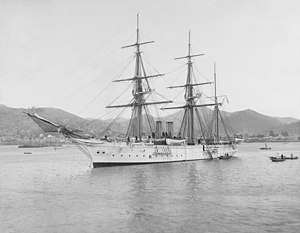
Back Arcona (Schiff, 1886) German اساماس آرکونا (۱۸۸۵) Persian SMS Arcona (1885) French 阿科纳号护卫舰 (1885年) Chinese
 Arcona in Nagasaki, Japan, c. 1897
| |
| History | |
|---|---|
| Name | Arcona |
| Namesake | Cape Arkona |
| Builder | Kaiserliche Werft Danzig |
| Laid down | 1881 |
| Launched | 7 May 1885 |
| Commissioned | 1 December 1886 |
| Renamed | Mercur, 1902 |
| Fate | Scrapped, 1906 |
| General characteristics | |
| Class and type | Carola-class corvette |
| Displacement | Full load: 2,662 t (2,620 long tons) |
| Length | 81.2 m (266 ft 5 in) |
| Beam | 12.6 m (41 ft 4 in) |
| Draft | 5 m (16 ft 5 in) |
| Installed power |
|
| Propulsion | |
| Speed | 14.1 knots (26.1 km/h; 16.2 mph) |
| Range | 4,180 nautical miles (7,740 km; 4,810 mi) at 8.5 knots (15.7 km/h; 9.8 mph) |
| Crew |
|
| Armament |
|
SMS Arcona was a member of the Carola class of steam corvettes built for the German Kaiserliche Marine (Imperial Navy) in the 1880s. Intended for service in the German colonial empire, the ship was designed with a combination of steam and sail power for extended range, and was equipped with a battery of ten 15-centimeter (5.9 in) guns. Arcona was laid down at the Kaiserliche Werft (Imperial Shipyard) in Danzig in 1881, she was launched in May 1885, and she was completed in December 1886.
Arcona was kept in reserve after completion until 1892, when she was activated for an extended deployment abroad. She protected German interests in Venezuela in 1892 before joining the Cruiser Division in German East Africa the following year. Later in 1893, she was sent to Brazil when a naval revolt threatened German nationals in the country. The outbreak of the First Sino-Japanese War in 1894 prompted the transfer of Arcona and two of her sister ships to East Asia as the nucleus of the East Asia Division, of which Arcona served as the flagship.
The ship was under repair when Otto von Diederichs seized the Jiaozhou Bay Leased Territory in China with the rest of the Division in 1897, and was therefore unable to participate in the operation, though she later assisted in defending the concession. Arcona then conducted survey cruises in the central Pacific Ocean and protected German nationals in the Philippines after the Spanish–American War in 1898. In early 1899, she was recalled to Germany, decommissioned in June, and renamed Mercur in January 1902. She was ultimately broken up in 1906.